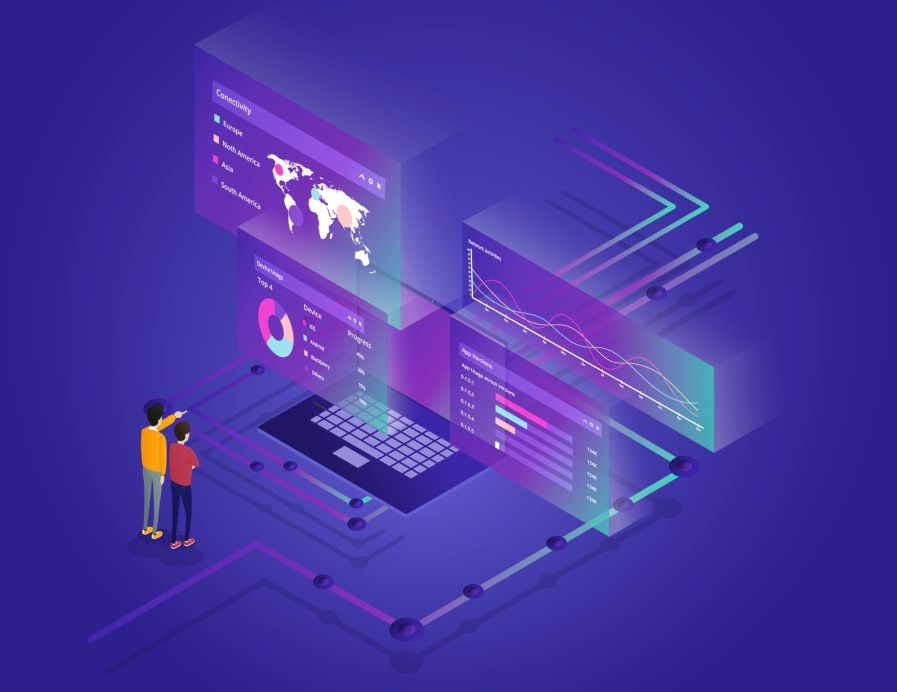Business owners today recognize the importance of data science and analytics in decision making. To effectively utilize this valuable resource, it is necessary to understand the principles of statistical thinking. Statistical thinking for data science and analytics gives business owners the foundational knowledge they need to get the most out of their analytics investments. This guide will discuss the fundamentals of statistical thinking and how it relates to data science and analytics.
What is Statistical Thinking?
Statistical thinking is the process of using data to inform decisions and create meaningful insights. It involves utilizing principles of probability, statistical analysis, and other mathematical methods to interpret large amounts of data to understand better how different variables are related. When data scientists use statistical thinking, they can use the data to draw meaningful conclusions about trends and patterns. This helps them make better decisions. Just as exploratory data analysis (EDA) is a vital first step in the data science process, statistical thinking is an essential part of the data science workflow. Things like predicting future trends and identifying potential risks are all done through the use of statistical thinking.
At its core, statistical thinking is about understanding relationships between variables and making informed decisions based on that understanding.
The Fundamentals of Statistical Thinking for Data Science and Analytics
Before we can use statistical thinking to its fullest potential, we must first understand the fundamentals.
Descriptive Statistics
This involves summarizing the data to provide a basic understanding of what the data looks like. It includes calculating a dataset’s mean, median, and standard deviation. When a data science approach is used, these calculations can be automated. Furthermore, descriptive statistics can create graphs, tables, and data summaries. Like you can use a graph to visualize trends in the data. Or, you can use tables to compare data points side by side.
Inferential Statistics
This is the process of using data samples to infer the population. That is, it can be used to infer characteristics of larger datasets from smaller samples taken from that population. It involves using statistical tests such as t-tests and ANOVA to test hypotheses about the data. Many things can be inferred about a population from these tests. The data visualization tools help understand the data and make accurately informed decisions.
Exploratory Data Analysis (EDA)
While descriptive and inferential statistics are important, they don’t provide a full picture of the data. EDA helps uncover patterns, correlations, and relationships that may be buried in the data. Visualization tools such as scatter plots, bar charts, and other graphical representations can help bring insights from the data that would otherwise remain hidden.
Data Mining
Data mining techniques are used to uncover patterns and relationships in large datasets. It utilizes techniques such as clustering and classification to discover important information that can be used for decision making. This includes uncovering customer preferences, detecting fraud, and predicting future trends. When statistical thinking and statistical thinking numerical data analysis are combined with data mining, powerful insights can be revealed.
Do you want to benefit from using statistical thinking for data science and analytics?
Contact Growth Hackers
What are the Benefits of Using Statistical Thinking for Data Science and Analytics?
Now that we understand the fundamentals of statistical thinking let’s explore some of the key benefits it provides to data science and analytics.
Improved Decision Making
Businesses can make better-informed decisions with more confidence and accuracy using statistical thinking techniques. This can help a company stay ahead of the competition and make optimal decisions for its success. When data collection and analysis are done correctly, statistical thinking can help assess various scenarios and identify the most beneficial course of action. Suppose you’re considering investing in a new technology or expanding into a new market. Statistical thinking can help by providing useful data that allows you to determine each decision’s potential risks and rewards.
Enhanced Modeling
Statistical thinking provides the tools to develop models that better capture real-world phenomena. By better understanding complex relationships, data scientists can create more accurate models and simulations. This will provide better insight into how decisions may play out in practice. Like a scientist studying a complex system, data scientists can use statistical thinking to develop models considering many variables and interconnections. When you obtain supporting evidence, it can help validate your models and make decisions more reliable.
Improved Forecasting
Statistical thinking can also improve the accuracy of forecasts. By considering various factors and analyzing data over time, data scientists can make more accurate predictions. Statistical thinking provides the tools and techniques to determine which factors are most important to consider when making a forecast and how they may affect the outcome.
In addition, it allows experimentation with different assumptions to see if different outcomes would occur based on slightly altered inputs. This is especially useful in uncertain times or decisions with long-term consequences. As the statistical foundation is stronger, forecasts will be more precise and reliable.
Increased Efficiency
Data scientists can also use statistical thinking to create more efficient processes. By understanding the data and assessing potential risks and rewards, businesses can develop systems that minimize waste and maximize efficiency. This may involve analyzing existing processes and finding ways to streamline them or automate certain tasks.
Statistical thinking can provide useful insight into the best way to structure a business to achieve the highest efficiency level. Additionally, by understanding how data can be used to measure performance, businesses can better track progress and ensure their processes are as effective as possible. Statistical thinking and data optimization are essential to any modern business and can help them stay competitive in the current environment.
Improved Communication
Finally, statistical thinking can help improve communication between stakeholders. By better understanding the data, decision-makers can make more informed decisions and explain them in a way that is easier to understand. This helps everyone involved understand why certain decisions are being made and how they will affect the future. Plus, understanding the data will enable stakeholders to communicate their findings and analyses accurately, ensuring that all stakeholders are on the same page.
What are the Goals of Statistical Graphics and Data Visualization?
Statistical graphics and data visualization goals are to make large and complex datasets easier to understand. Through visual representations like charts, graphs, maps, and other visual elements, it is possible to quickly discern trends or patterns in data that would otherwise be difficult to uncover.
Additionally, these visual tools can help draw attention to specific correlations or phenomena. By providing a visual representation of data, statistical graphics and data visualization can make it easier to communicate the results of an analysis or study in a meaningful way. In addition to making complex datasets easier to comprehend, these techniques can also create an enhanced understanding of relationships between various variables within a dataset.
In data science and analytics, statistical graphics and data visualization can identify relationships, trends, outliers, correlations, and other patterns in a dataset that can inform decision making. They can also quickly assess the validity or accuracy of machine-learning algorithms’ models.
In addition, data visualization tools can make it easier to identify potential areas for further exploration and research. By making complex datasets more accessible and understandable, these techniques can help uncover valuable insights that might otherwise remain hidden. Informed decisions based on data.
Unlock the power of data. Use statistical thinking for data science and analytics today!
What are the Challenges Associated with Statistical Thinking for Data Science and Analytics?
Just as with any field of study, there are challenges associated with data science and analytics. One of the biggest challenges is understanding the underlying principles of statistical thinking.
Statistical thinking involves using data to draw inferences about a problem or topic. This means that one must be comfortable working with large datasets and be able to interpret the results in an unbiased manner.
Additionally, statistical thinking requires knowledge of probability and statistics – two fields that can be difficult to master. Another challenge associated with data science and analytics is the time it takes to analyze a dataset properly. This requires patience, diligence, and an understanding the underlying principles of statistical thinking to generate accurate results.
Finally, data scientists must be able to communicate their findings effectively to ensure that their work has an impact on the organization they are working for. This requires understanding how to use data visualizations, such as charts and graphs, to present information that is easy to comprehend.
These challenges require practitioners to have strong analytical skills, understand current trends in data science and analytics, and be able to customize solutions for each specific problem. Additionally, data science professionals must constantly develop new techniques and approaches as the field of data science is constantly evolving.
Closing Thoughts About Statistical Thinking for Data Science and Analytics
Statistical thinking is a powerful tool for data scientists and analytics professionals. It provides the ability to develop models that better capture real-world phenomena, improve forecasting accuracy, increase efficiency, and improve stakeholder communication. By using these techniques effectively, businesses can make more informed decisions with greater confidence and accuracy. Ultimately, this will help them stay competitive in the current environment and give them a competitive edge in their respective markets.
Growth Hackers is surely one of the best data analytics agencies helping businesses from all over the world grow. There is no fluff with Growth Hackers. We help entrepreneurs and business owners use statistical thinking for data science and analytics, increase their productivity, generate qualified leads, optimize their conversion rate, gather and analyze data analytics, acquire and retain users and increase sales. We go further than brand awareness and exposure. We make sure that the strategies we implement move the needle so your business grow, strive and succeed. If you too want your business to reach new heights, contact Growth Hackers today so we can discuss about your brand and create a custom growth plan for you. You’re just one click away to skyrocket your business.








